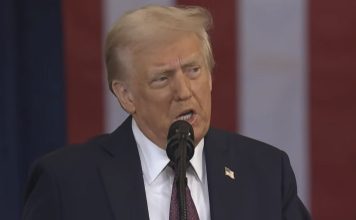On a clear late-October day, U.S. Border Patrol Chief Rodney Scott and several of his deputies are standing at a high point on the San Diego County side of the border with Mexico next to a 30-foot-high slotted steel fence that didn’t exist three years ago. The rust-colored barrier, the northern part of the new dual-fence system that makes up President Donald Trump’s signature “border wall,” dives down the hill, and curves leftward before carving a straight line toward the sea.
Scott, who spent most of his career here, ending as chief of the San Diego sector before heading to Washington to lead the agency, recalls how Border Patrol agents’ jobs have changed from the height of illegal immigrant crossings in the late 1980s and 1990s. There were either no fences or very primitive ones back then, and border agents would catch roughly one in 10 illegal crossers with the others slipping easily past them, he notes. Some were searching for a better life, others had more sinister missions involving drugs or human trafficking.
“Where we’re standing right now, early in my career, I wasn’t allowed to come back here unless I was with a team and we had long arms because it was considered so dangerous,” Scott says.
Scott and Aaron Heitke, the San Diego sector chief, point out new housing developments on both the U.S. and Mexican sides of the border, which have been built in recent years or are in the planning stages as the area has grown safer and more controlled.
Roughly a half mile from the border wall on the U.S. side, San Diego County recently started constructing a new campground with plans to add a soccer field. There is already a baseball diamond nearby, and hikers, bikers and horseback riders now regularly use a network of trails that crisscross the hillside and coastal flats, providing sweeping undeveloped views.
“As the campground site evolved over the years, we were confident that this would be a safe, enjoyable amenity for visitors,” Donna Durckel, a communications officer for San Diego County, tells RealClearPolitics.
It’s a story of increasing U.S. government control over the border and one that Trump administration officials are highlighting in the final days before the Nov. 3 election.
Donald Trump’s promise to build a “big, beautiful wall” along the southern border was a centerpiece of his 2016 campaign, but the divisive issue has been largely absent this time around, given the national focus on the coronavirus pandemic. But progress on the wall will get some late-campaign attention with U.S. Customs and Border Protection officials planning to hold a ceremony marking the completion of 400 miles of the barrier this week, according to a Department of Homeland Security official.
At campaign rallies, Trump still regularly touts the construction as a major promise kept, a line he repeated during his last debate with Democratic nominee Joe Biden.
“We now have a stronger border than we’ve ever had,” he said. “We’re now over 400 miles of brand-new wall. You see the numbers. We let people in, but they have to come legally.”
True to form, his statement was a bit of an exaggeration. Construction crews over the last several months have been pushing hard to reach the 400-mile pre-election goal, building some two miles a day with plans to complete 450 miles by the end of the year.
Those last 50 miles are proving to be the most difficult as crews use dynamite to level terrain up and down canyons in the final stretch planned for San Diego, as well as in some areas in Arizona. The Trump administration has ramped up construction in that state this year by building on federal land, where the work cannot be slowed by legal action to enforce environmental laws, archaeological reviews and other types of roadblocks. It has faced tougher hurdles in south Texas, one of the busiest areas for border crossings, because much of the land where the government wants to build is privately owned.
The contrast between Biden and Trump on expanding construction beyond 400 miles of new border wall is just as stark as so many other aspects of their campaigns. Biden has pledged to put an immediate end to construction of the new barrier if elected, although he would keep what’s already built so far and add high-tech surveillance systems to areas.
Critics have pointed out that only a small portion of Trump’s wall – 20 miles – has been constructed on land where no barriers previously existed.
At least in the San Diego sector, Border Patrol officials argue that such criticism is myopic because newly installed barriers are far more effective than the two-layer dilapidated fencing that previously existed and was easily overcome by crossers.
The fence layer closest to the Mexican side of the border was constructed of rusting Vietnam War-era helicopter landing pads, pieced together and installed from 1991 through 1995. The eight-foot tall solid metal fence was easily scaled, and border agents had no way of seeing what was on the other side. Mounds of dirt were commonly built up on the Mexican side, making for an easy climb.
A few years later, authorities installed a second layer of metal mesh fencing, but it became obsolete with the widespread use of tools that could cut through the material in 40 seconds.
In March 2018, the U.S. government began construction of the two-layer bollard-style fence that stands today and extends eastward from near the ocean for 14 miles, the last few of which are still under construction.
This type of wall appears more like a fence with slim, open slots that allow agents to see what’s happening on the other side. Its design – the way the bollards are arranged – allows the wall to become “solid” at an angle, thus providing agents greater protection against gun shots or other projectiles.
Border officials argue the new fencing, which is extremely difficult to climb, is keeping their agents far safer, and they point to signs that it’s already become an effective deterrent to illegal crossings and drug smuggling.
In the San Diego sector, officials say there has been a record number of maritime arrests over the last year as the agency has been able to shift more resources up the coast to help with the greater number of maritime illegal crossings and drug smuggling, Scott tells RCP.
But based on apprehension statistics alone, it’s nearly impossible to discern exactly how effective the new wall has been since construction first began in early 2018. Administration officials have argued the wall, as well as the controversial “remain in Mexico” policy, are helping stem the tide of illegal immigration despite a record number of arrests last year. The “remain” policy requires asylum seekers to stay in Mexico as they await hearings in the United States.
Several constantly shifting factors impact the number of people attempting to cross the border illegally in any given year, including the economic conditions and fluctuating levels of violence in other countries, along with demands for cheap labor in the U.S.
In fiscal year 2020, the San Diego sector border patrol apprehended 53,282 illegal crossers, an 8% drop from 2019 when the number was 58,049, according to U.S. government figures. Over the last year, those numbers include a 44% decline in unaccompanied juveniles and a 69% decrease in family units – but single adult apprehensions increased 20%.
Last year, authorities also seized 178 pounds of heroin, 383 pounds of fentanyl, 492 pounds of cocaine, 7,169 pounds of methamphetamine and 10,829 pounds of marijuana. While the amount of cocaine and heroin seized decreased from fiscal year 2019 to 2020, the amounts of other drugs found and confiscated were either at similar levels or increased.
Another potential reason for this year’s decrease in apprehensions of illegal crossers is an emergency policy the administration has instituted during the coronavirus pandemic. Agents can bypass normal immigration judicial proceedings and asylum protections to return all illegal crossers to Mexico within hours of their arrests.
About 37% of those arrested have tried to cross the border more than once, a 30% increase over the previous year, which officials attribute to the U.S. COVID policy of expelling people immediately. Thus, the policy has a downside: If someone is caught trying to smuggle drugs into the country, they are simply returned back to Mexico with no immediate consequences, allowing some to become repeat offenders.
The Supreme Court said earlier this month it would take up a case involving the remain-in-Mexico policy, along with the way in which Trump funded parts of the wall’s construction by transferring $2.5 billion funds from the Pentagon’s budget. Lower courts have ruled against both, although the Supreme Court issued an order last year allowing the wall construction to continue while the legal challenges play out.
The high court now has a 6-3 conservative advantage after Justice Amy Coney Barrett’s confirmation and swearing in Monday evening, but it isn’t expected to render a decision on these two administration border policies until next year.
Next week’s election will determine whether the border wall will be an integral ongoing piece of Trump’s stricter immigration policies or simply a piecemeal relic of it.
Susan Crabtree / RealClearPolitics
Go to Source
Reposted with permission













![WATCH: Elon Musk Town Hall Rally in Green Bay [FULL Video]](https://www.wisconsinrightnow.com/wp-content/uploads/2022/04/Elon_Musk_3018710552-356x220.jpg)



![The Wisconsin DOJ’s ‘Unlawful’ Lawman [WRN Voices] josh kaul](https://www.wisconsinrightnow.com/wp-content/uploads/2025/03/MixCollage-29-Mar-2025-08-48-PM-2468-356x220.jpg)
















